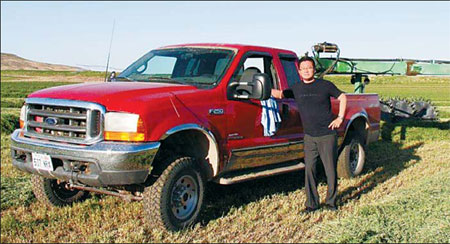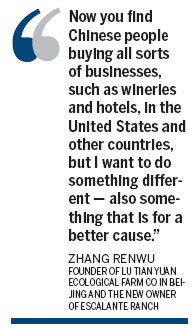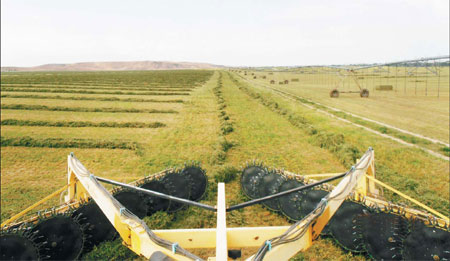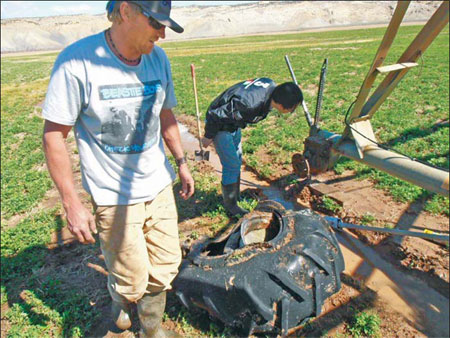Beijing throws Utah a haymaker
Updated: 2012-07-18 11:14
By Zhang Yuwei (China Daily)
|
||||||||
|
Alfalfa being cut in the fields at the Escalante Ranch in Utah. The Chinese businessman Zhang Renwu paid "something over $10 million" for the 8,900-hectare ranch and is growing alfalfa for export to China. Photos Provided to China Daily |
|
Above: Ranch manager Frank Biggs (left), and Roger Qiao, an employee of Lu Tian Yuan in Beijing, check the farm machinery. Below: Simon Shao, co-owner and the local executive who oversees the recently purchased ranch, poses for a photo on a visit during the alfalfa harvest. |


Goal is healthier, lucrative output from better-fed dairy cows in China, owner says. Zhang Yuwei reports from New York
Around noon on a sunny, early June day in northern Utah, Frank Biggs is on his tractor, busily cutting for a second time the season's alfalfa harvest on the Escalante Ranch.
A middle-aged Chinese man waves to Biggs from the field, holding a bowl of soup noodles with his other hand.
He is Zhang Renwu, 46, founder of Lu Tian Yuan Ecological Farm Co in Beijing and the new co-owner of the ranch, whose name is Spanish for "climber".
"My new boss really shows appreciation for my work, and even delivers lunch he made to my tractor. That never happened before," said Biggs, a 37-year-old native of the tiny town of Jensen (population about 400), where the ranch is located. He has worked at Escalante for eight years.
The 22,000-acre (8,900-hectare) ranch, which went on the market for $16 million last year, was previously owned by a Tennessee-based billionaire as a vacation getaway. He visited only once or twice a year for hunting.
Zhang, who has been in the alfalfa hay importing and exporting business for about two decades, had been searching for just such a deal. In December, two months after visiting the Utah ranch, he and business partner Simon Shao, a Chinese-American, signed a deal to buy the property through a US entity they set up.
Zhang wouldn't specify what they paid but said it was "something over $10 million" and "reasonable".
"I'll use the ranch differently from the previous owner since it will mostly be used for growing alfalfa. The 3,500 acres of irrigated land and the surroundings are great for it," he said.
Shao, co-owner and the local executive who oversees the ranch, says the two have put in about $200,000 in fertilizers so far to make the land cultivable and improved an additional 500 acres for growing alfalfa.
The purchase, recounted Biggs, "caught a few people off guard" when locals heard the buyer was a Chinese businessman - a first for Jensen, as far as anyone can tell.
"Now you find Chinese people buying all sorts of businesses, such as wineries and hotels, in the United States and other countries, but I want to do something different - also something that is for a better cause," said Zhang.
"It is important to provide high-quality alfalfa hay to cows in China to keep the good quality of dairy products. It's a big mission that I want to continue," he explained.
Utah's Department of Agriculture and Food considers the deal an innovative way to create jobs in the state.
"We encourage investors - both from all of the US and the world, to invest in livestock or agriculture in Utah," department spokesman Larry Lewis told China Daily. "There is much land, and a lot of resources that can be put to use to grow alfalfa or other crops for export to other countries."
Chinese investment in ranches in Utah "doesn't necessarily need to have happened before", Lewis said, adding that the ranch "will be a good size of operation and surely will increase the production of alfalfa in Utah".
Ken Mirr, owner of Denver-based Mirr Ranch Group, which brokered the Escalante sale, said he liked dealing the two buyers because the transaction closed quickly after the lawyer's review. The sale has opened the door to more international clients for his firm, Mirr said.
There were "a number of competing interests" for the Utah ranch, the broker said, but it went to Zhang and Shao because of their interest in growing alfalfa, which will generate farming income for the state.
"It was also a good showplace for other foreign investors to see a very unique ranch that others might be able to purchase in the west," Mirr said.
After the purchase, Zhang kept Biggs on as ranch manager as well as two ranch hands. "They know their stuff very well, and they are very hard-working people," the new owner explained.
"My new boss actually cares about the employees," Biggs said. "As long as he treats me fairly, I will continue to work for him, just like any other job."
Not only is it good for the processors, whose business is to compress raw alfalfa for export, more alfalfa production will, like "a chain effect" over the long term, generate jobs in other areas, too, Lewis said.
"Our governor and our state are trying to increase the number of jobs in the state and this will help us reach that goal," the agriculture official said.
Escalante Ranch is adjacent to Dinosaur National Monument, which straddles the Utah-Colorado border and is named for the giant reptiles that once roamed what are now desert canyons. Hard by the Green River - Zhang indicated he as the owner has water rights - the ranch hosts some of the richest soil for alfalfa and grain cultivation.
In the United States, the world's biggest producer, over 99 percent of all alfalfa hay bound for export is grown in seven western states, including Utah, according to the National Alfalfa and Forage Alliance.
The number of exporters licensed by the US Department of Agriculture to ship to China has increased to more than 70 from 17 in recent years, said Shao. Both Zhang and Shao visit Escalante about once a month, sometimes more frequently during the harvest, which runs from March to October.
Zhang, a native of Inner Mongolia, has been working in agriculture since he graduated with a degree in biology from Shandong University in the late 1980s. He has been involved in exporting and importing alfalfa hay since 2007, buying the crop from licensed US processors and shipping it to China.
Last year Zhang shipped about 50,000 metric tons of alfalfa in the form of double-compressed bales to China, compared with 5,000 metric tons when he first started his business five years ago.
"It's hard to imagine that it actually may cost less to ship from Long Beach, California, to cities in China than to ship between cities in China," he said.
Zhang's Lu Tian Yuan company in Beijing's Changping district, with about 300 employees in three factories in the capital and Inner Mongolia, is one of the earliest and biggest suppliers of alfalfa pellets in China. Its clients include what Zhang says are well-known Chinese dairy brands, though he declines to name them, and customers from Japan and South Korea.
Even with the increasing need for alfalfa hay to feed dairy cows, the rapidly decreasing quantity of arable land in China has affected productivity of the crop domestically, said Zhang.
"It's true not all the dairy producers can afford the high-quality alfalfa, but paying a bit more can increase the output and quality of the dairy products, which will eventually create sales value for the producers," Shao said.
In Utah, Lewis said: "We think it's a great idea; it makes perfect sense. Consumers in China are seeking more protein in their diet. In order to feed livestock in China, you need better, high-quality grains, feeds and hay."
"This will help bridge a business relationship between the two countries," he added, referring to the US and China. "One relationship will possibly encourage more and build up more business in Utah."
Increasing alfalfa to about half of a cow's diet is a good way to boost protein requirement in milk to the international standard of 3.2 percent (compared with China's current 2.8 percent), or higher, said Lu Xinshi, a professor at Beijing Forestry University.
"Alfalfa in the diet can also help extend a cow's milking life and increase the quality of dairies," Lu said.
As owner of the Utah ranch, Zhang is legally an alfalfa-hay provider and can do business with alfalfa processors in the US directly, making his business sustainable, as he puts it.
"We have seen the price increase from about $200 a ton two years ago to more than $400 a ton last year," said Shao. "It looks good and may still be on the rise."
To supply its growing dairy industry, China bought 96,000 metric tons of alfalfa hay from the US in the first quarter of 2012, more than half of last year's total and 200 percent above the first three months of 2011, according to the Denver-based Livestock Marketing Information Center.
"China's buying patterns will likely be highly dependent on their domestic forage production. The faster forage production meets demand in China, the less China will need to source forage from the US and other countries," said Katelyn McCullock, a dairy and forage economist with the center, which connects USDA economists, industry representatives and university agricultural extension agents.
Top US alfalfa export destinations include the biggest buyer Japan, the Republic of Korea, China and the United Arab Emirates. The latter two have become fast-growing markets for alfalfa exports in recent years, according to the USDA.
"The last three years have seen explosive growth in alfalfa hay going to China," McCullock said. "It is doubtful that the Chinese will continue to buy at such a high growth rate long-term. However, it remains difficult to predict the domestic forage-supply situation in China and when exports will slow down."
Zhang, who just returned to Beijing after visiting Utah, said he aims to obtain 40,000 to 50,000 metric tons of alfalfa - including through purchases of nearby farms' crop - this year. That, he predicts, could translate into "more than a million" dollars in income.
Escalante's location in a basin between mountain ranges makes it ideal as a grazing spot for several species of wild game. In late summer and early fall, deer and elk migrate to the ranch seeking food and space. That's when hunting season starts, said Zhang, who plans to develop a hunting business after the end of alfalfa harvesting this fall.
"The lodge on the ranch is well-equipped and can accommodate about a dozen people at a time," he said.
Meanwhile, his hunt for additional farmland is on.
"I am looking at more farms now in Utah and other states and considering buying more."
Contact the writer at yuweizhang@chinadailyusa.com

 Relief reaches isolated village
Relief reaches isolated village
 Rainfall poses new threats to quake-hit region
Rainfall poses new threats to quake-hit region
 Funerals begin for Boston bombing victims
Funerals begin for Boston bombing victims
 Quake takeaway from China's Air Force
Quake takeaway from China's Air Force
 Obama celebrates young inventors at science fair
Obama celebrates young inventors at science fair
 Earth Day marked around the world
Earth Day marked around the world
 Volunteer team helping students find sense of normalcy
Volunteer team helping students find sense of normalcy
 Ethnic groups quick to join rescue efforts
Ethnic groups quick to join rescue efforts
Most Viewed
Editor's Picks

|

|

|

|

|

|
Today's Top News
Health new priority for quake zone
Xi meets US top military officer
Japan's boats driven out of Diaoyu
China mulls online shopping legislation
Bird flu death toll rises to 22
Putin appoints new ambassador to China
Japanese ships blocked from Diaoyu Islands
Inspired by Guan, more Chinese pick up golf
US Weekly

|

|








